Learn how to make this gorgeous buttercream flower cake! It’s made with tender vanilla cake layers and frosted with delicious homemade buttercream.
This design may look intimidating, but I promise you only have to make two types of buttercream flowers!! It’s easier than you might think.
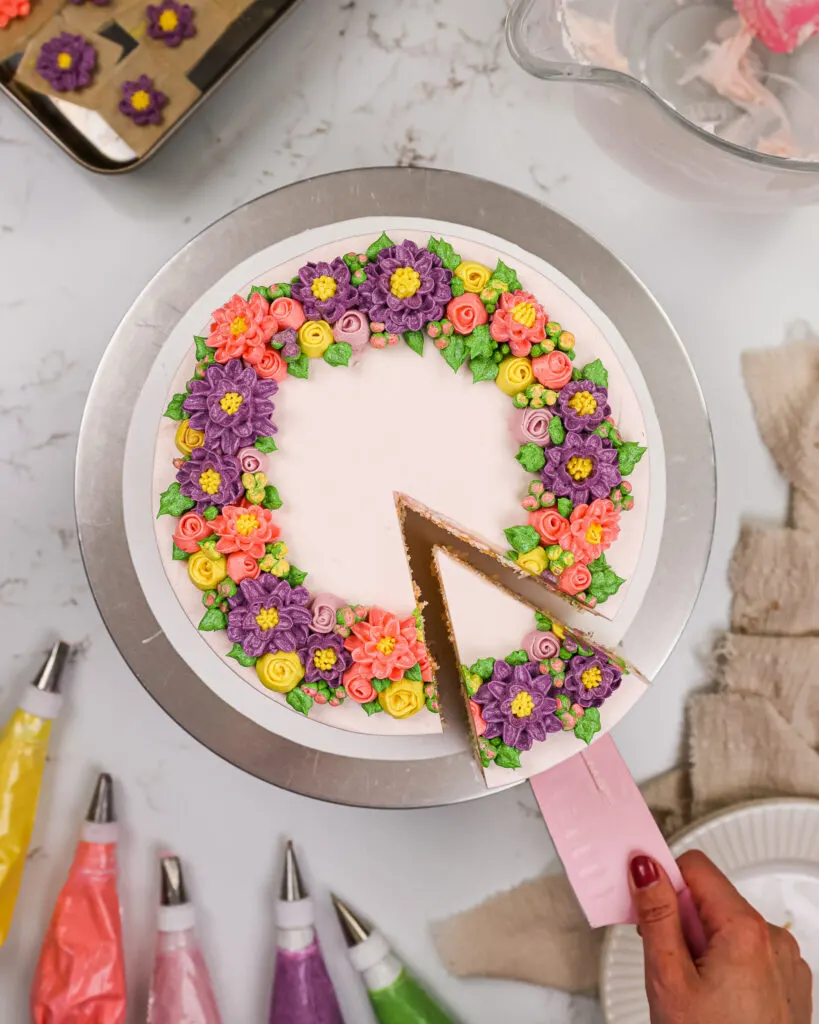
What You’ll Need to Make this Buttercream Flower Cake
To make this cake you’ll need a few different frosting tips! While this list might seem long, most (if not all) of tips can be found in a majority of beginner frosting kits.
I’ve listed a couple brands that make some of these tips, but there are tons of other brands that make them as well!
The most important thing is just that the shape and size of the tip you use is similar to what I recommend below.
- 4 Small Piping Bags (I use 12-inch bags)
- Petal Tip like an Ateco 103 or a Wilton 103
- Small C-Shaped Piping Tip like an Ateco 80
- Small Leaf Tip like a Wilton 352
- Grass Piping Tip like an Ateco 133 or a Wilton 233
- Small Round Piping Tip like an Ateco 5
- 4 Frosting Couplers
- Flower Nail
- Stand mixer or electric hand mixer
- Whisk attachment
- Greaseproof Cake Board
- Spinning Cake Stand
- Large Offset Spatula
- Bench Scraper
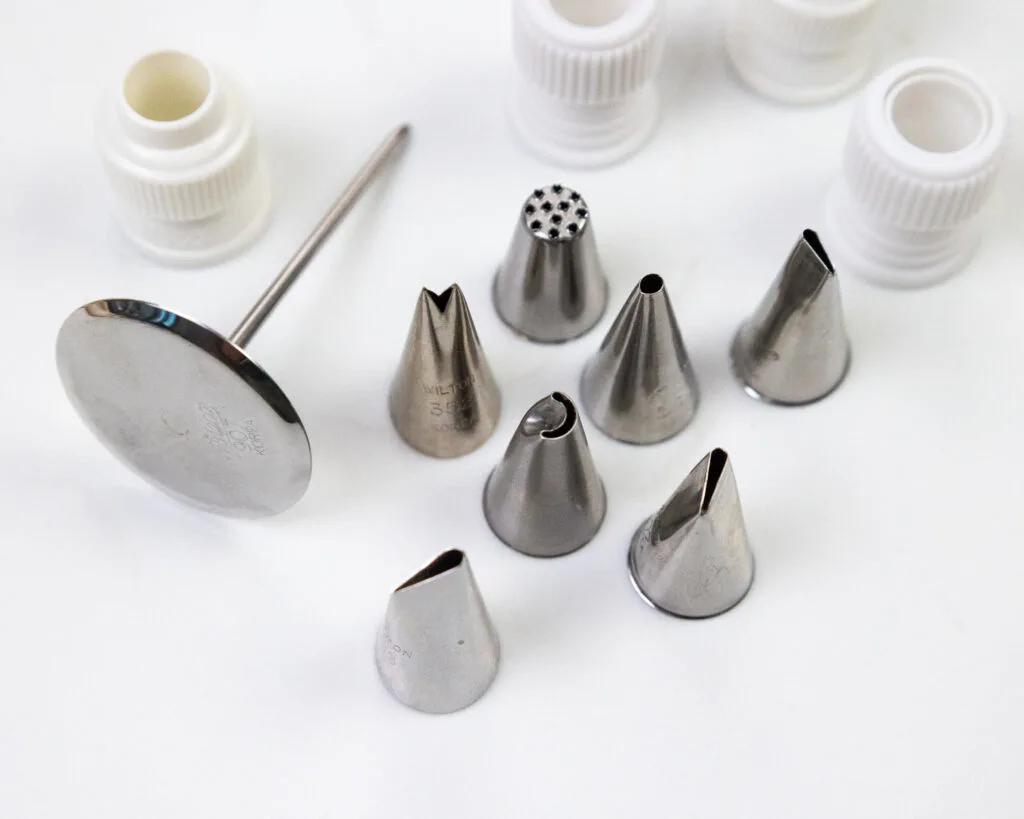
How to Make a Buttercream Flower Cake
To make sure this cake turns out as amazing as possible, let’s walk through each step together!
I’ve also included a video tutorial of the process below.
Step 1: Make the Fluffy Vanilla Cake Layers
I recommend making the cake layers first! It gives them time to bake and cool before you assemble the cake.
Once that batter is ready, divide it evenly between the prepared cake pans.
I like to use a digital kitchen scale to weigh my pans, to make sure my layers will be the same height.
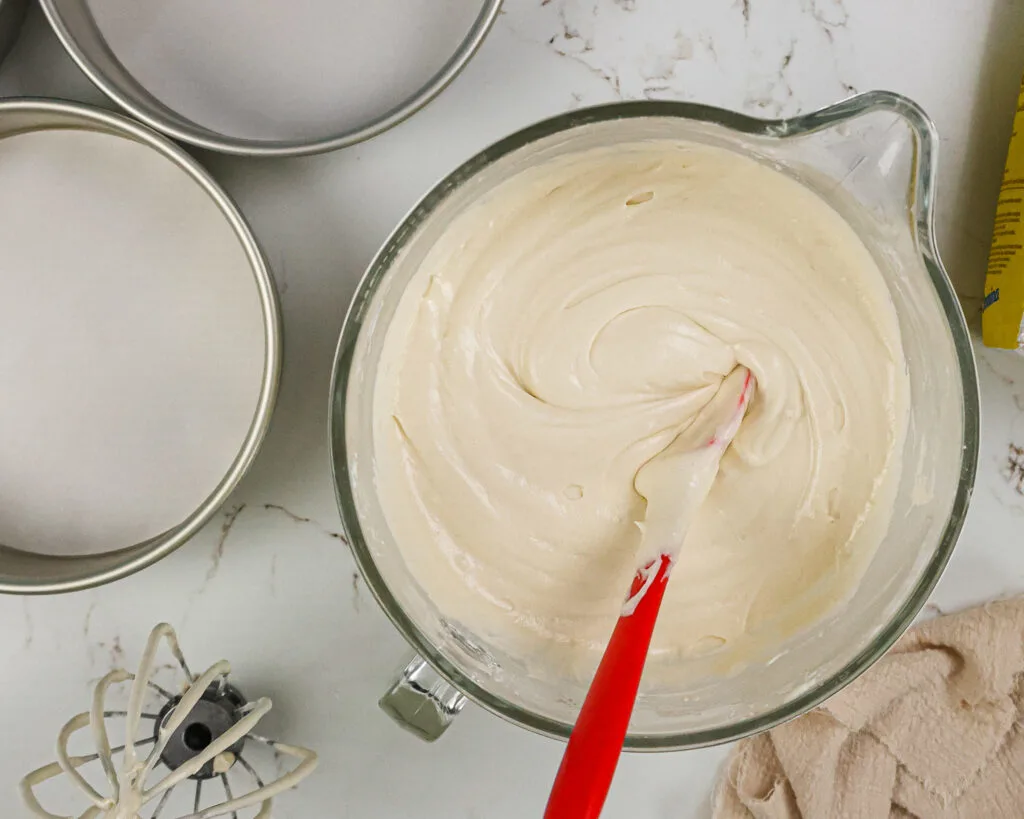
Bake for 34-36 minutes or until a toothpick comes out with a few moist crumbs. Rotate pans halfway through to help them bake evenly.
Allow the pans to cool for 10 minutes, then run an offset spatula around the perimeter of the pan to separate the cake from the pan.
Place cake layers into the freezer for 45 minutes to accelerate the cooling process.
Once the layers are fully cooled, carefully flip the pans and remove the layers from the pans.
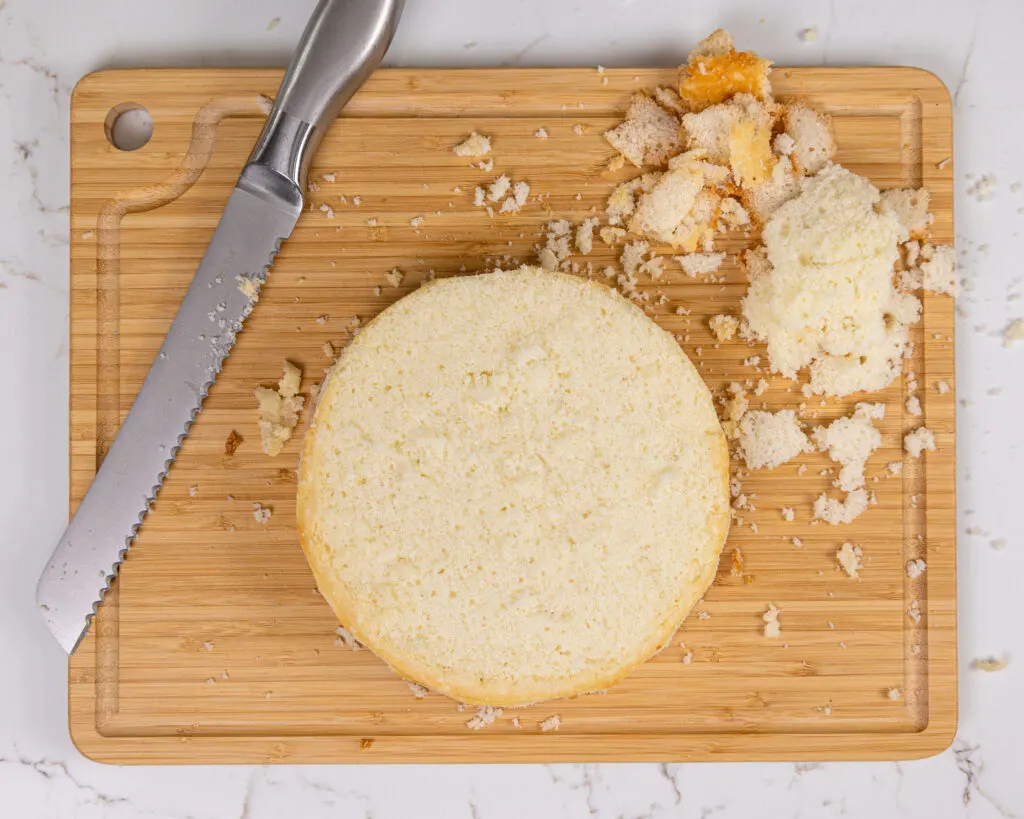
Use a serrated knife to level the top of each cake layer, then set aside. If you make these in advance, wrap and freeze them at this point.
Step 2: Make the Vanilla Buttercream Frosting
While the cake layers bake and cool, make the buttercream frosting.
I firmly believe that the best type of frosting for piping buttercream flowers is American buttercream!
It is super easy to make, is one of the most stable types of buttercream and it’s the easiest to color.
However, if you think American buttercream is too sweet, you can also use Swiss meringue buttercream or Italian meringue buttercream.
I like to add in a small squirt of pink gel food coloring to make the base frosting that will be used to fill and cover the cake a pale shade of pink.
This gives the cake a beautiful, finished look and makes it feel more connected to the colorful buttercream flowers.
Mix the frosting by hand with a rubber spatula for a couple minutes once it’s made. This will give it a silky smooth consistency that makes it easier to pipe with.
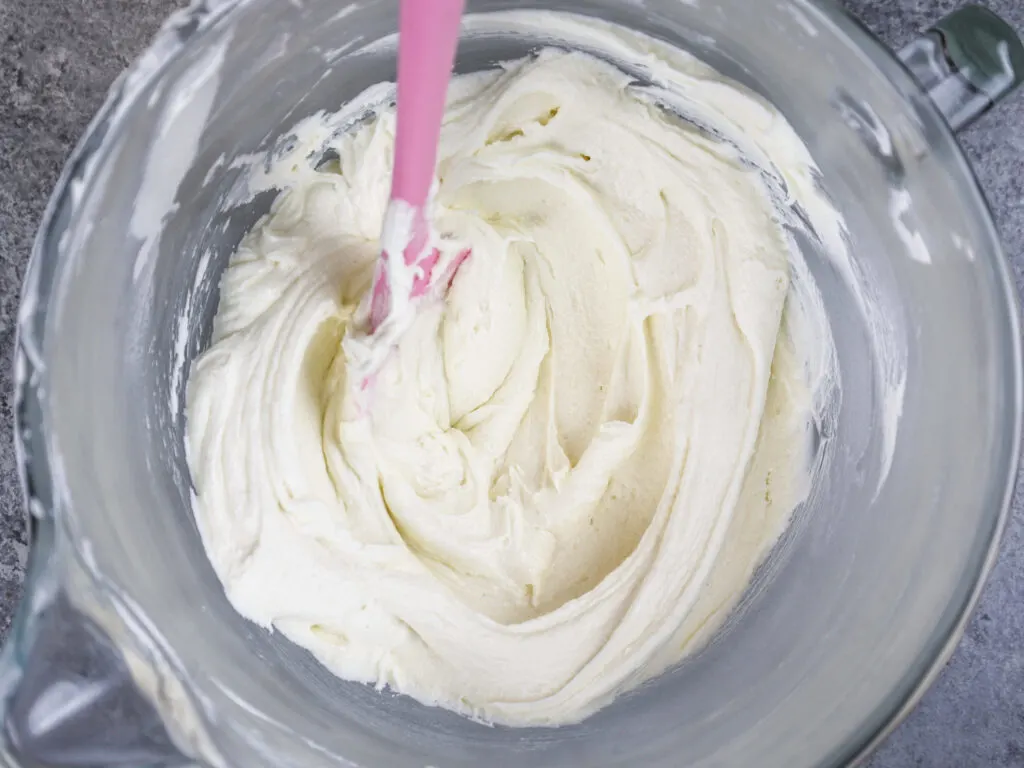
If the frosting seems too thick, add in additional cream (1 Tbsp at a time). Or if the frosting is too thin, add in more powdered sugar (1/4 cup at a time).
If you’re not sure what consistency you’re look for, check out my buttercream consistency guide.
Cover the frosting with plastic wrap to prevent it from crusting and set aside.
Step 3: Stack and Frost the Cake Layers
If possible, chill your cake layers in the freezer for 20 minutes before assembling the cake.
It makes them cold to the touch, which minimizes crumbing and makes them so much easier to frost and stack.
Spread about 1 Tbsp of frosting onto a greaseproof cake board or plate, then place your first cake layer on top of frosting smear. This helps the layer stay in place as you assemble the cake.
Spread a thick, even layer of buttercream on top of the cake layer.
Repeat with the remaining cake layers and flip the top cake layer upside down (cut side down).
This makes it easier to frost your cake and get sharp edges.
Chill the cake in the fridge (30 minutes) or freezer (10 minutes) until the frosting is firm to the touch.
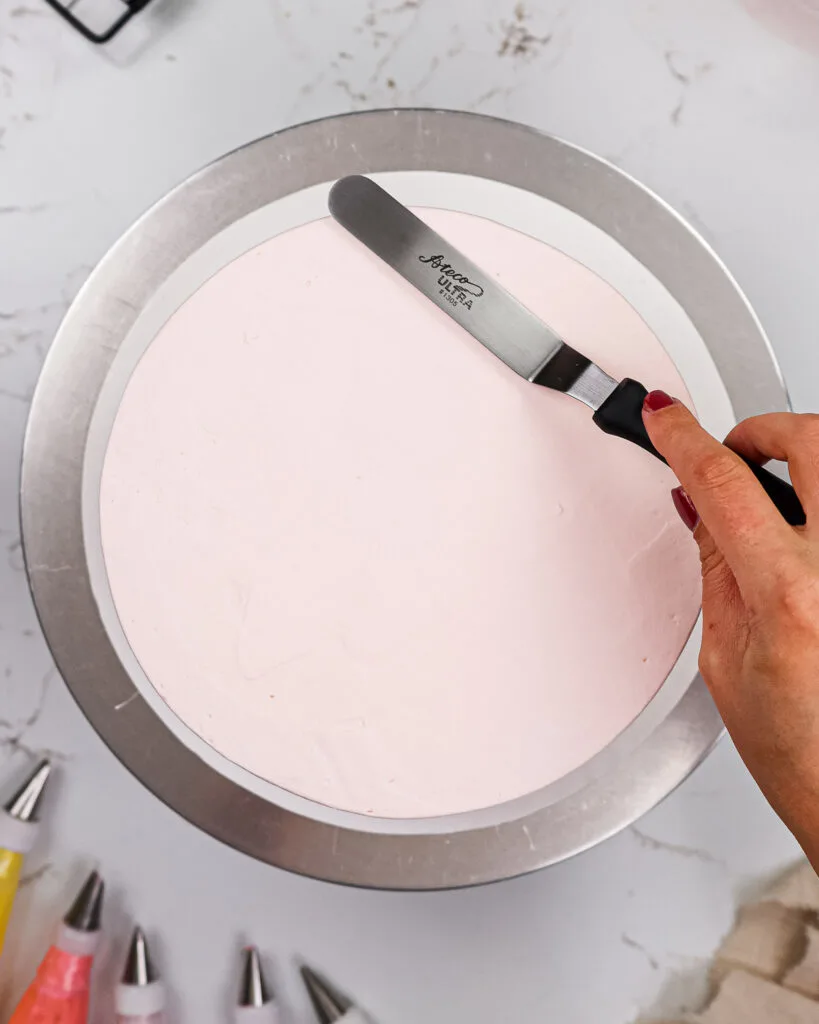
Add a thick, second layer of frosting around the cake, then use a large offset spatula and bench scraper to smooth the frosting.
Place the cake in the fridge to chill while you pipe the buttercream flowers.
Step 4: Make the Buttercream Flowers
Divide the remaining buttercream into four bowls and color them four different colors. I chose to use pink, purple, yellow, and green. However, you can use whatever color scheme you like!
Now this is going to sound strange but mix a small spoonful of each color of frosting into each bowl.
This helps the colors blend better and have a more cohesive look. It sounds crazy but trust me it works!

Place each frosting in its own piping bag fit with a coupler. This will allow you to swap out your piping tips and make different flower designs with the same color of frosting. Seal the top of each bag with a rubber band and set aside.
Cut out about 40 small, 1.5-inch squares of parchment paper. Pipe a tiny dab of frosting on top of your flower nail and press a square of parchment paper on top of it.
Use the petal tip to make swirl roses and the grass shaped tip and the c-shaped tip to make chrysanthemums.
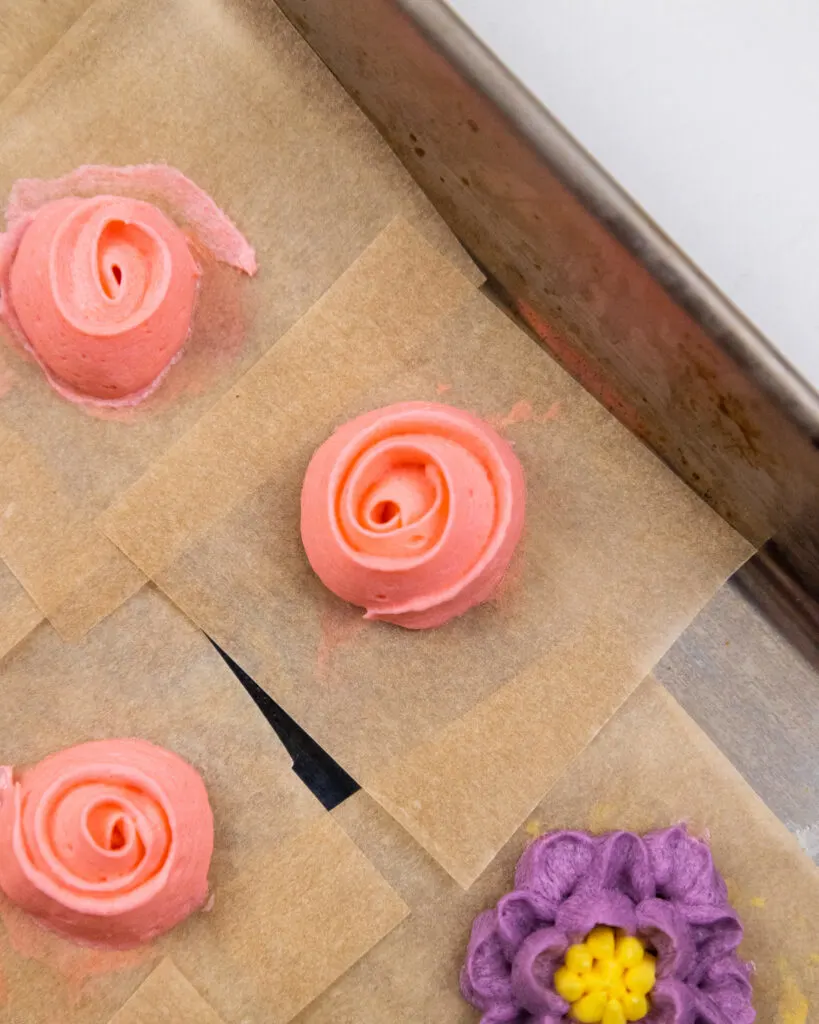
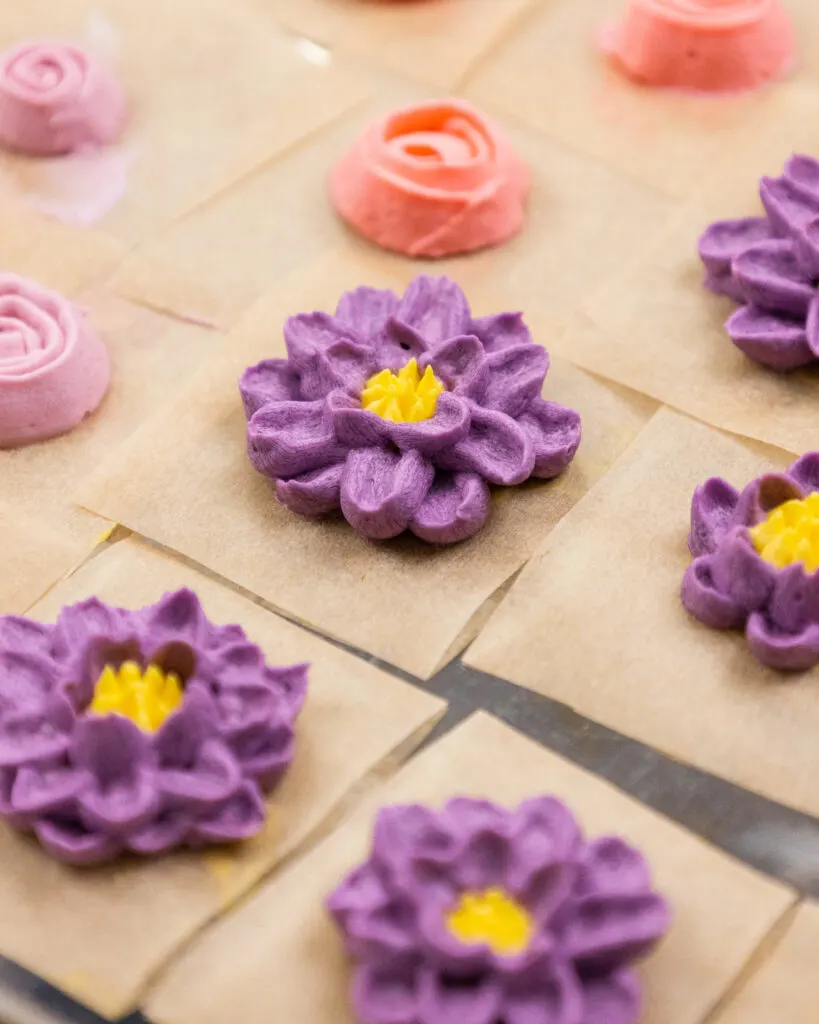
Pipe 5 large chrysanthemums, 10 small chrysanthemums, and 25 small swirl roses in a variety of colors.
After piping each flower, carefully remove the parchment square from the flower nail and place on a flat baking sheet or plate.
Place the flowers in the freezer for about 5 minutes, or until they’re firm to the touch.
Remove the cake from the fridge and pipe a ring of buttercream on top of the cake.
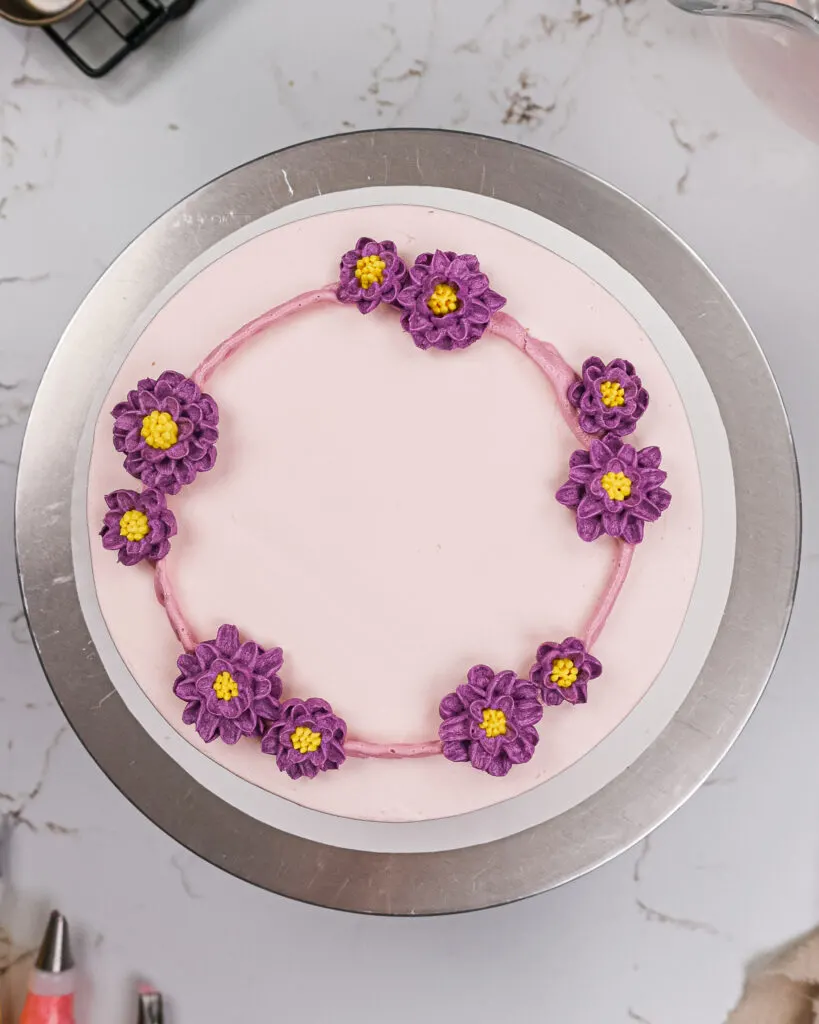
Carefully peel the flowers off the parchment paper and place them in a ring around the top of the cake.
Fill in any gaps with green buttercream by making leaves with the leaf tip and little flower buds with the round tip. Then enjoy!
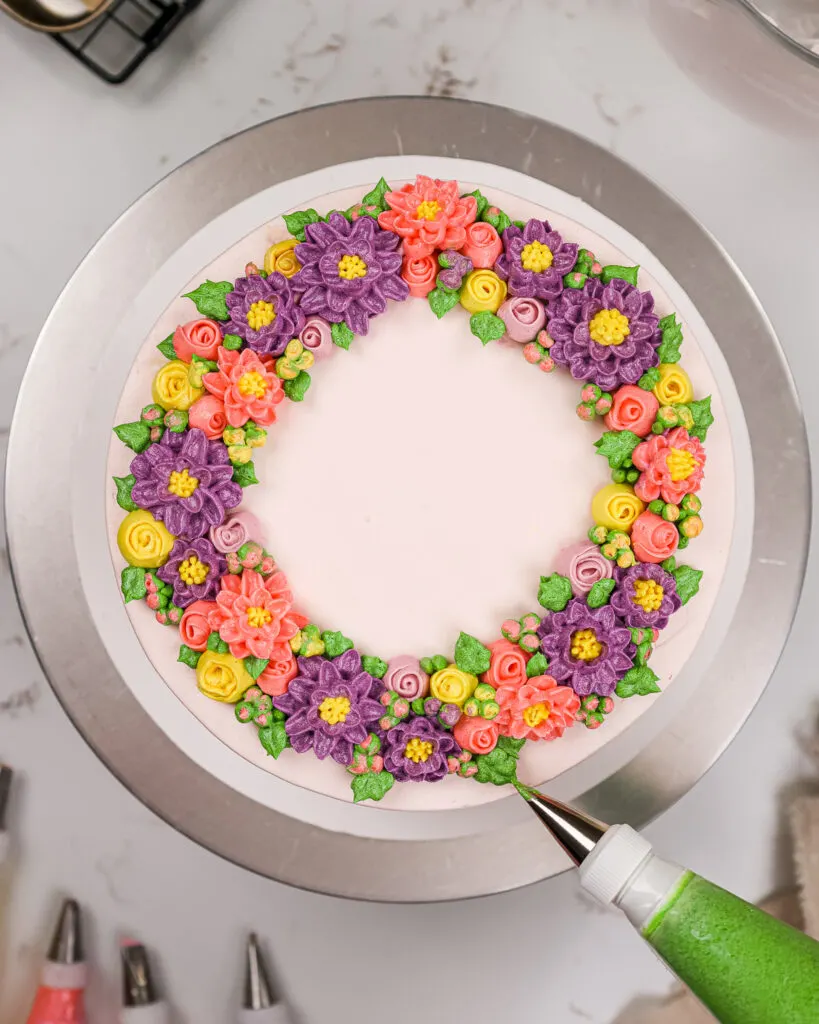
Substitutions & Swaps – Buttercream Flower Cake
Some swaps and substitutions that can be made in this recipe include:
- Unsalted Butter – If you only have salted butter on hand, you can use it in place of the unsalted butter. Just be sure to omit the salt that this recipe calls for. You can also use vegan butter in its place!
- Cake Flour – If you can’t find cake flour, you can make your own makeshift cake flour using this method or use all-purpose flour. You can also swap in a good gluten-free flour blend (like this) if needed. Just be sure to stir the batter longer than normal to help give the cake proper structure, and let the batter sit for about 20 minutes before baking it if you opt to make a gluten-free version.
- Egg whites – I like to use the type that come in a carton so that I don’t have to separate my eggs, but you can also use fresh egg whites. If you have an egg allergy you can try using a vegan egg replacer in the cake batter.
- Sour Cream – You can also use full fat yogurt, buttermilk, whole milk, or an alternative yogurt or milk (almond, soy, oat).
- Vegetable Oil – Use any flavorless oil in this recipe.
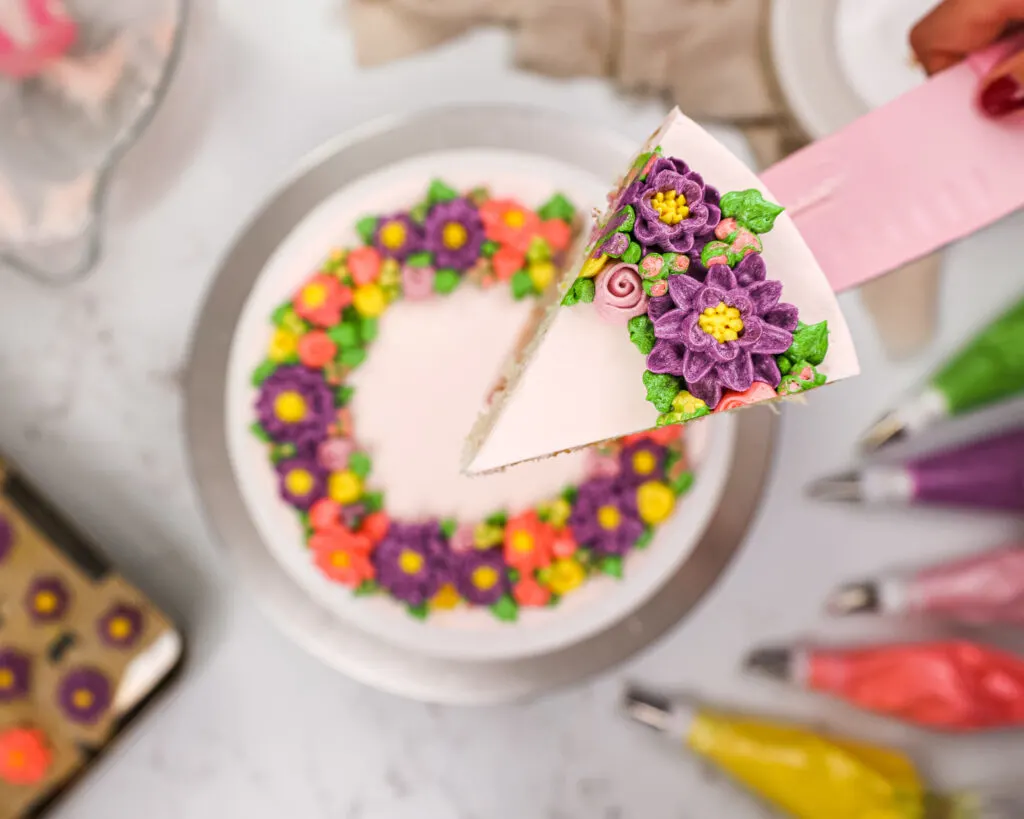
Substitutions & Swaps: American Buttercream Frosting
- Unsalted Butter – If you only have salted butter on hand, you can use it in place of the unsalted butter. Just be sure to omit the salt that this frosting recipe calls for. You can also use vegan butter in its place!
- Heavy Cream – You can use whole milk or alternative milk (soy, almond, oat) instead of heavy cream or whipping cream. This will thin the frosting out more though, so I recommend using about half the amount the recipe calls for.
- Gel Food Coloring – Natural food coloring or liquid food coloring can be used if needed to color the frosting. However, I find gel food coloring works best!
Tips for Making the Best Buttercream Flower Cake
- Ingredients at room temp mix together better! Set out any cold ingredients ahead of time.
- Properly measure your flour (spoon into the cup measure, then level). Or better yet, use a kitchen scale to measure your dry ingredients.
- Use a scale to weigh your cake pans as you fill them. It will make your cake layers bake to the same height and bake more evenly.
- Bang your cake pans on the counter before putting it in the oven. This brings any big air bubbles that are trapped in the batter to the surface.
- Level your room temperature or thawed cake layers with a serrated knife to make them easier to stack.
- Chill your cake layers in the freezer for about 20 minutes before assembling the cake. It makes it so much easier to stack and frost them!
- Use gel food coloring to create brightly colored frosting. It works best because it doesn’t throw off the consistency of the frosting or give it a bitter taste.
- If your hands run hot, wrap a paper towel, or thin kitchen towel around your piping bag to prevent the transfer of heat from your hands into the frosting.
- Take breaks as you pipe on the buttercream flowers to prevent hand cramps.

Making This Buttercream Flower Cake in Advance and Storage Tips
Make your cake layers in advance and freeze them. It breaks the process up and makes it more approachable.
Make the frosting ahead of time or save any leftover frosting. Store it in an airtight container in the fridge for up to a month. Just be sure to give it a good stir once it thaws to make it nice and smooth again. This cake can last in the fridge for up to a week.
A frosted cake can last in the fridge for up to a week, or in the freezer up to a month. If you freeze the cake, transfer it to the fridge the night before you plan to eat it.
This will help it gradually thaw and minimize any temperature shock. Remove the cake from the fridge about 30 minutes before you plan to cut into it.
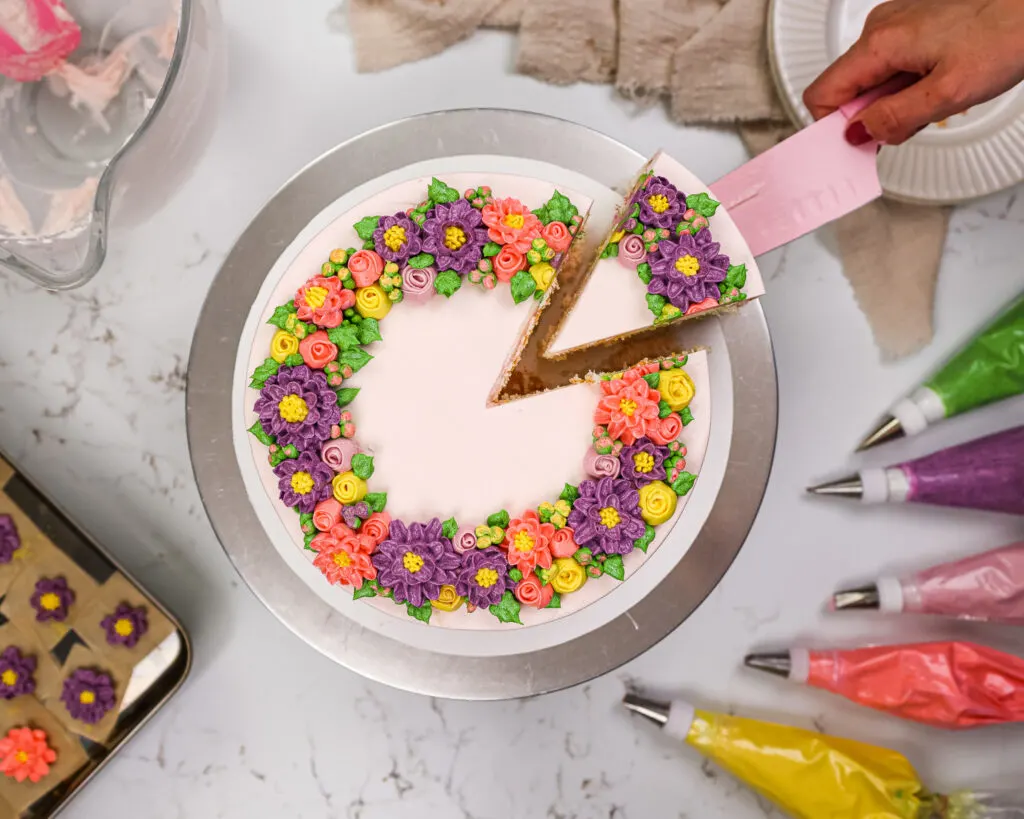
Let Me Know What You Think
If you try this cake recipe and tutorial, I’d love to hear what you think! Please leave a rating and comment below with your thoughts.
Don’t forget to tag me @chelsweets and use #chelsweets on social media so I can see your amazing creations!
Other Recipes You Might Like:
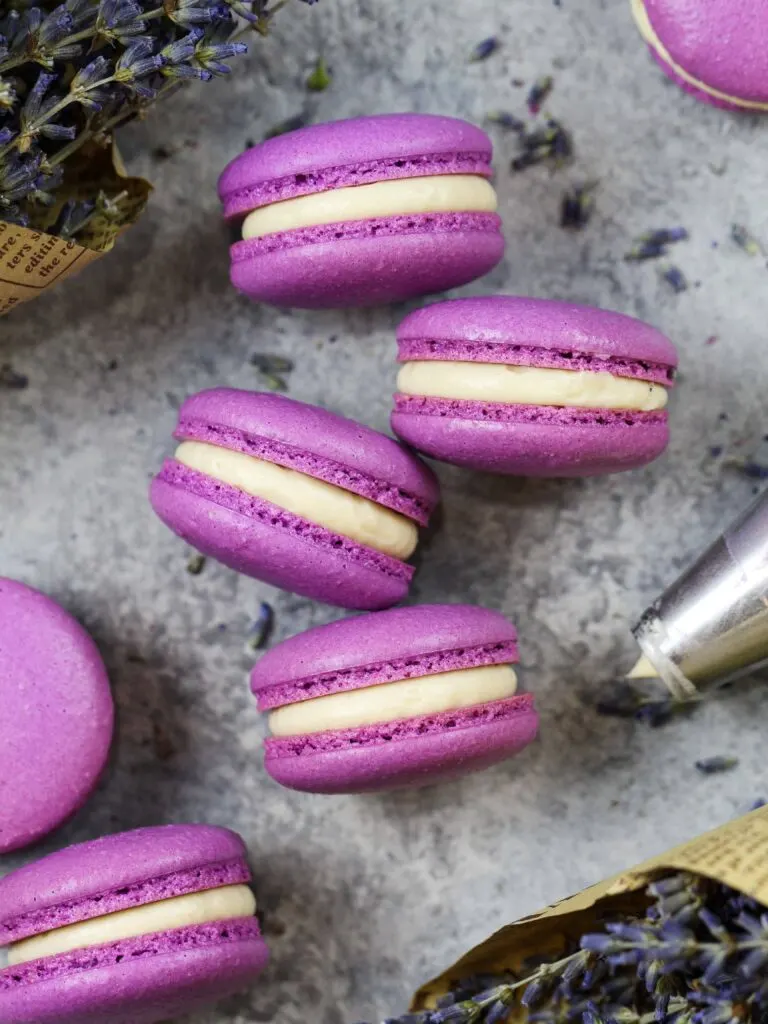
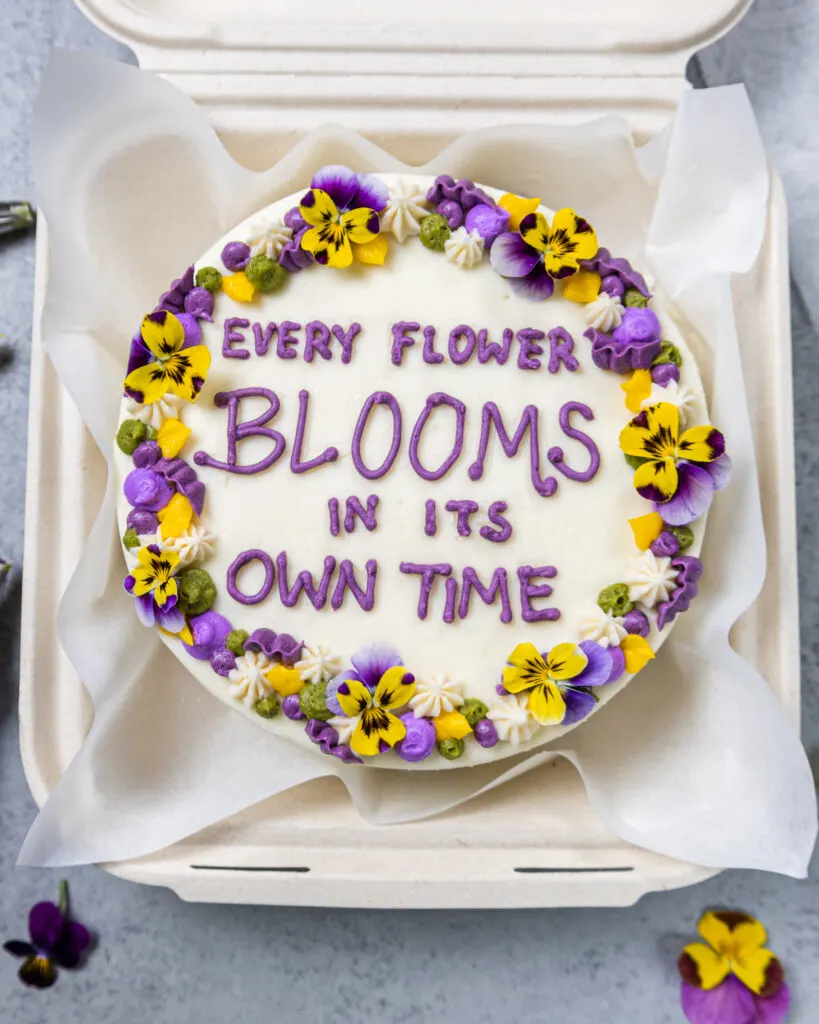

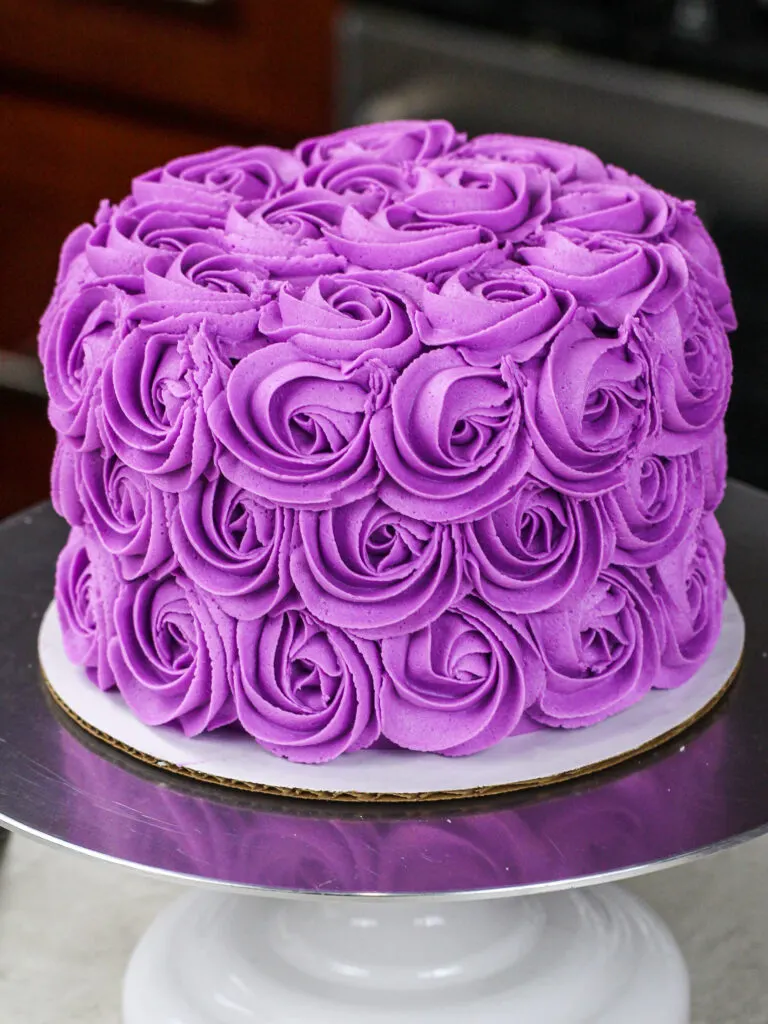
Buttercream Flower Cake
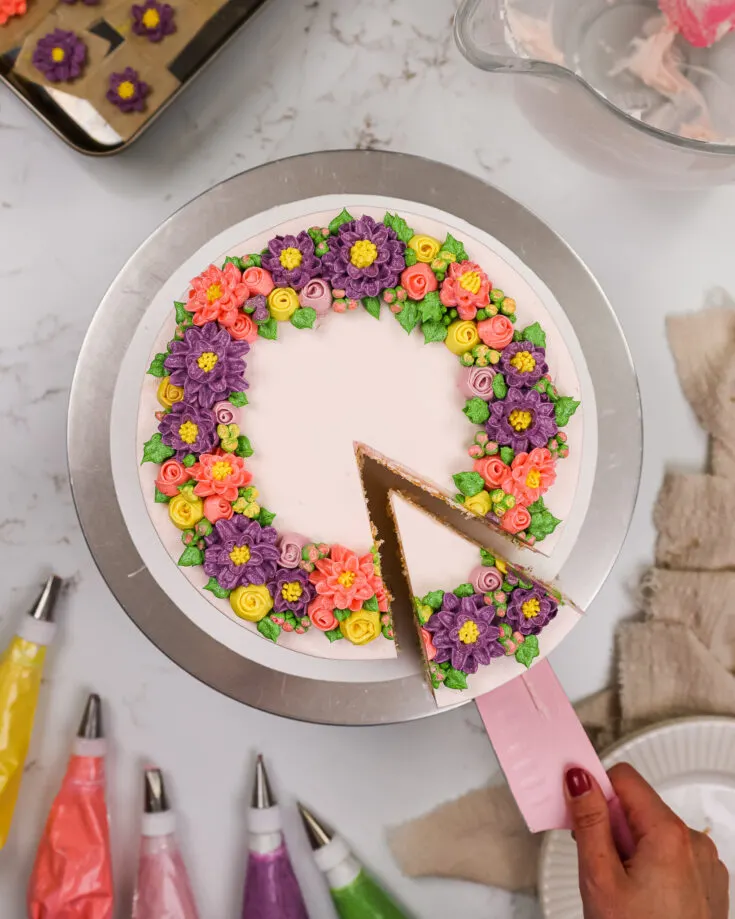
Learn how to make this gorgeous buttercream flower cake! It's made with tender vanilla cake layers and frosted with delicious homemade buttercream.
Ingredients
Vanilla Cake Recipe
- 1 cup or 2 stick unsalted butter, room temperature (226g)
- 3 cups granulated sugar (600g)
- 1 cup pasteurized egg whites from a carton or 7 egg whites (240ml)
- 3 cups cake flour (360g)
- 1 Tbsp baking powder (12g)
- 1 tsp salt (4g)
- 1 1/2 cups full-fat sour cream, room temperature (360g)
- 1/4 cup vegetable oil (60ml)
- 1 tsp vanilla extract (4ml)
Vanilla Buttercream Frosting
- 2 cups unsalted butter, room temperature (452g; 1 lb box)
- 1 tsp vanilla extract (4ml)
- 1/2 tsp salt (3g)
- 7 cups powdered sugar (907g; 2 lb bag)
- 1/3 cup heavy cream or heavy whipping cream (80g)
- Pink, purple, yellow and green gel food coloring
Tools and Equipment Needed
- Stand mixer or electric hand mixer
- Whisk attachment
- Greaseproof Cake Board
- Spinning Cake Stand
- Large Offset Spatula
- Bench Scraper
- 4 Small Piping Bags
- Medium-Sized Petal Tip like an Ateco 103 or a Wilton 103
- Small C-Shaped Piping Tip like an Ateco 80
- Small Leaf Tip like a Wilton 352
- Grass Piping Tip like an Ateco 133 or a Wilton 233
- Small Round Piping Tip like an Ateco 5
- 4 Frosting Couplers
- Flower Nail
Instructions
Fluffy Vanilla Cake Layers:
- Preheat oven to 350°F/175°C. Line and grease three 8-inch cake pans with parchment rounds.
- Add 1 cup of unsalted butter and 3 cups of granulated sugar into the bowl of a stand mixer. Beat on a high speed with a whisk attachment for a couple of minutes, scraping down the sides of the bowl as needed with a rubber spatula. The mixture will become lighter in color as air is whipped into it.
- Add 1 cup egg whites and mix at a medium-high speed until the mixture looks fluffy and increases in volume.
- In a large bowl whisk together 1 1/2 cups of cake flour, 1 Tbsp baking powder, and 1 tsp salt.
- Mix 1/2 of the dry ingredients into the butter /egg mixture on medium speed until incorporated.
- Add 1 1/2 cups of sour cream, 1/4 cup vegetable oil, and 1 tsp vanilla extract. Mix at a medium speed until combined, scraping the sides and bottom of the bowl as needed.
- Mix in the remaining dry ingredients at a low speed.
- Divide batter evenly between the prepared cake pans. I like to use a digital kitchen scale to weigh my pans, to make sure my layers will be the same height.
- Bake for 34-36 minutes or until a toothpick comes out with a few moist crumbs. Rotate pans halfway through to help them bake evenly.
- Allow the pans to cool for 10 minutes, then run an offset spatula around the perimeter of the pan to separate the cake from the pan.
- Place cake layers into the freezer for 45 minutes to accelerate the cooling process. Once the layers are fully cooled, carefully flip the pans and remove the layers from the pans.
- Use a serrated knife to level the top of each cake layer, then set aside. If you make these in advance, wrap and freeze them at this point.
Vanilla Buttercream Frosting:
- While the cake layers bake and cool, make the buttercream frosting.
- Beat 2 cups of unsalted butter on a medium-high speed for 1-2 minutes with a paddle attachment until the butter becomes lighter in color.
- Mix in 1 tsp vanilla extract and 1/2 tsp salt on a low speed.
- Slowly add in 7 cups of powdered sugar. Halfway through, add 1/3 cup of heavy cream to make the frosting easier to mix.
- If desired, add in a small squirt of pink gel food coloring to make the base frosting that will be used to fill and cover the cake a pale shade of pink. Beat on low until the ingredients are fully incorporated and the desired consistency is reached.
- If the frosting is too thick, add in additional cream (1 Tbsp at a time). If the frosting is too thin, add in more powdered sugar (1/4 cup at a time). Cover the frosting with plastic wrap to prevent it from crusting and set aside.
Assembling This Buttercream Flower Cake:
- If possible, chill your cake layers in the freezer for 20 minutes before assembling the cake. It makes them cold to the touch, which minimizes crumbing and makes them so much easier to frost and stack.
- Spread about 1 Tbsp of frosting onto a greaseproof cake board or plate, then place your first cake layer on top of the frosting smear. This helps the layer stay in place as you assemble the cake.
- Spread a thick, even layer of buttercream on top of the cake layer.
- Repeat with the remaining cake layers and flip the top cake layer upside down (cut side down). This makes it easier to frost your cake!
- Chill the cake in the fridge (30 minutes) or freezer (10 minutes) until the frosting is firm to the touch.
- Add a thick, second layer of frosting around the cake, then use a large offset spatula and bench scraper to smooth the frosting. Place the cake in the fridge to chill while you pipe the buttercream flowers.
Making the Buttercream Flowers:
- Divide the remaining buttercream into four bowls. Color one pink, one purple, one yellow, and one green. Now this is going to sound strange but mix a small spoonful of each color of frosting into each bowl. This helps the colors blend together better and have a more cohesive look. It sounds crazy but trust me it works!
- Place each frosting in its own piping bag fit with a coupler. This will allow you to swap out your piping tips and make different flower designs with the same color. Seal the top of each bag with a rubber band and set aside.
- Cut out about 40 small, 1.5-inch squares of parchment paper. Pipe a tiny dab of frosting on top of your flower nail and press a square of parchment paper on top of it. Use the petal tip to make swirl roses and the grass-shaped tip and the c-shaped tip to make chrysanthemums.
- Pipe 5 large chrysanthemums and 10 small chrysanthemums with the c-shaped piping tip (Ateco 80), and 25 small swirl roses with the petal tip (Wilton 103) in a variety of colors. After piping each flower, carefully remove the parchment square from the flower nail and place it on a flat baking sheet or plate. Place the flowers in the freezer for about 5 minutes, or until they're firm to the touch.
- Remove the cake from the fridge and pipe a ring of buttercream on top of the cake. Carefully peel the flowers off the parchment paper and place them in a ring around the top of the cake.
- Fill in any gaps with green buttercream by making leaves with the leaf tip (Wilton 352) and little flower buds with the round tip (Ateco 5). Then enjoy!
Notes
Tips for Making the Best Buttercream Flower Cake:
- Ingredients at room temp mix together better! Set out any cold ingredients ahead of time.
- Properly measure your flour (spoon into the cup measure, then level). Or better yet, use a kitchen scale to measure your dry ingredients.
- Mix the cake batter just until the ingredients are incorporated. This will ensure your cake layers are tender and fluffy.
- Use a scale to weigh your cake pans as you fill them. It will make your cake layers bake to the same height and bake more evenly.
- Bang your cake pans on the counter before putting them in the oven. This brings any big air bubbles that are trapped in the batter to the surface.
- Level your room temperature or thawed cake layers with a serrated knife to make them easier to stack.
- Chill your cake layers in the freezer for about 20 minutes before assembling the cake. It makes it so much easier to stack and frost them!
- Use gel food coloring to create brightly colored frosting. It works best because it doesn't throw off the consistency of the frosting or give it a bitter taste.
- If your hands run hot, wrap a paper towel, or thin kitchen towel around your piping bag to prevent the transfer of heat from your hands into the frosting.
- Take breaks as you pipe on the buttercream flowers to prevent hand cramps.
Making This Cake in Advance and Storage Tips:
You can make these cake layers in advance and freeze them. It breaks the process up and makes it more approachable.
Make your frosting ahead of time too or save any leftover frosting! It can be stored in an airtight container in the fridge for up to a month, or in the freezer for up to 3 months. Be sure to give it a good stir once it thaws to get the consistency nice and smooth again.
A frosted cake can last in the fridge for up to a week, or in the freezer for up to a month. The buttercream locks in all the moisture, keeping the cake fresh and delicious!
If you cut into the cake and have leftovers, use any remaining frosting to cover the cut section to keep it moist and store it in the fridge for up to a week.
Nutrition Information
Yield
24Serving Size
1Amount Per Serving Calories 598Total Fat 31gSaturated Fat 17gTrans Fat 0gUnsaturated Fat 12gCholesterol 79mgSodium 270mgCarbohydrates 77gFiber 0gSugar 62gProtein 4g

Easy Mirror Glaze: 5-Ingredient Recipe and Tutorial
Wednesday 7th of February 2024
[…] Buttercream Flower Cake Ombre Rosette Cake […]
Christine K
Sunday 28th of January 2024
The list of ingredients says "cake flour," but the directions refer to "self-rising cake flour" AND 1 tablespoon of baking powder. Which is correct?
I've been baking for over 30 years, and have noticed layer cake recipes now require the same amount of sugar as flour. This seems like an excessive proportion of sugar to flour, plus the cake tastes way too sweet. Why do these new layer cake recipes require so much more sugar than before?
Chelsweets
Sunday 28th of January 2024
Hi Christine,
Apologies, that is a typo! The ingredients list is correct and I've updated the instructions portion.
I can't speak to other recipes you've tried, but this recipe uses the reverse creaming method which requires a bit more sugar to give it a tender texture. You can reduce the sugar by 1/2 cup if you find this recipe too sweet, but if you reduce it any more it will negatively impact the texture of the cake.
Elizabeth
Tuesday 4th of April 2023
I’ve been making your vanilla cake for a while now. How does this fluffy vanilla cake compare to the original vanilla cake recipe? Which would you recommend for a wedding cake?
Chelsweets
Friday 7th of April 2023
Hi Elizabeth,
Great question! This cake has a slightly lighter crumb (thanks to the cake flour) and a more neutral flavor thanks to the sour cream it uses instead of buttermilk.
It really comes down to you preference in flavor! I love the texture of this cake, but I like a little tang in my cake to balance out the sweetness of the frosting (which is why my classic vanilla cake recipe with buttermilk is usually my go to). Both would taste great as a wedding cake!
Earl Grey Lavender Cake: Delicious Recipe from Scratch
Friday 9th of December 2022
[…] Buttercream Flower Cake Sunflower Cupcakes Strawberry Layer Cake Angel Food Cake […]